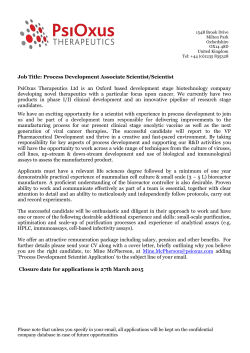
Design for Production of Oxalic Acid from Sugary Wastes
COLLEGE OF ENGINEERING Chemical, Biological & Environmental Engineering PRODUCTION OF OXALIC ACID FROM SUGARY WASTES Project Overview OBJECTIVE Multiform Harvest uses industrial waste streams to produce fertilizer (struvite). Calcium inhibits this process, but can be precipitated out with addition of oxalic acid. Oxalic acid can be produced by Aspergillus niger (black mold) fed with lactose from whey permeate, a waste product from the dairy industry. This project develops a process for producing oxalic from whey permeate for wastewater treatment applications. Ammonia, Oxalic Phosphate Acid Calcium Waste rich -Ca2+ -Mg2+ Water waste Treatment runoff METHODS Cell concentration can be measured by dry weight. Lactose concentration can be measured with a blood glucose monitor after hydrolysis by lactase. Oxalic acid can be quantified by precipitation with calcium chloride and subsequent titration with potassium permanganate. Measured Lactose (g/L) Base/Media Inlet Temperature Sensor Fig. 7: USDA cell line that preferentially produces oxalic acid has been cultured and will be used in further experiments. pH Sensor Sampling Port Fig. 4: Freeze dried A. niger from Shanghai Touchhealthy Biotechnology have been used in bioreactor trials. BIOREACTOR TRIALS Both artificial whey permeate and whey permeate from Darigold have been used as growth media in a batch bioreactor. Struvite Fig.1: Oxalic acid facilitates formation of struvite from a waste stream, such as dairy waste or landfill leachate, by removing calcium ion. 9 8 7 6 5 4 3 2 1 0 Brenna Baker, Kaitlyn Bjornson, Anthony Vickery, Jennifer Lux Fig. 3: The bioreactor uses a PID controller to control temperature with a heat exchanger and pH by adding acid or base from an attached source. Samples are taken with a syringe from the sampling port. Darigold whey permeate Artificial whey permeate Cmeasured = 1.2*Cpredicted R² = 0.97 0 1 2 3 4 5 6 7 8 Predicted Lactose (g/L) Artificial Whey Permeate Recipe: • 10 g/L peptone • 10 g/L yeast extract • 50 g/L lactose Bioreactor Operating Conditions: • pH = 6 • Temperature = 30°C • Agitation Rate = 250 rpm Heat Exchanger Inlet/Outlet Cell Concentration (g/L) Calcium Oxalate Future Work and Bioreactor Scale-Up Fig. 8: Growth kinetics (modeled in MATLAB) predict cell, lactose, and oxalic acid concentrations which are used for assessing scale-up properties. SCALE-UP CONSIDERATIONS A scaled-up process will be designed to treat 100,000 gal/day waste stream containing 300 ppm Ca2+ and will consider: • Growth kinetics from bioreactor trials 30 • Adequate oxygen and nutrient transport (well mixed) Artificial Real 25 20 • Configuration (continuous flow) and whey/waste stream flow rates ACKNOWLEDGEMENTS 15 The team would like to acknowledge Keith Bowers from Multiform Harvest, Katherine Hilt, Greg Chandler, Curtis Lajoie, Christine Kelly, Andy Brickman, the OSU Dairy, the USDA, and Philip Harding. 10 5 0 0 9 Fig.2: Calibration curve of lactose added versus lactose measured. Lactose is hydrolyzed and then glucose is measured by a ReliOn Ultima Blood Glucose sensor. Lactose is calculated from a stoichiometric conversion from the sensor reading. Error bars represent 90% confidence intervals. An ideal correlation would have a linear regression slope of one. Fig. 5: Cell pellets from batch bioreactors. Cell mass color and consistency is different between cells fed with artificial and real whey. 20 40 Time (hr) 60 80 Fig. 6: Cell concentration versus time for bioreactor with real whey permeate from Darigold and artificial whey permeate. Cell concentration is measured by weighing a dry cell pellet from the bioreactor. Continued cell growth in the drying process may lead to inconsistencies in data. There appears to be similar concentrations for both artificial and real whey permeate; whey permeate from Darigold with no additional nitrogen source supplies sufficient nutrients.
© Copyright 2025












